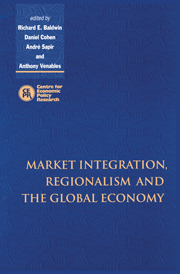Book contents
- Frontmatter
- Contents
- List of figures
- List of tables
- Preface
- Acknowledgements
- List of conference participants
- 1 Introduction
- PART ONE REGIONALISM AND THE GLOBAL ECONOMY
- 2 Regionalism vs. multilateralism
- Discussion
- 3 Preferential agreements and the multilateral trading system
- Discussion
- 4 Politics and trade policy
- Discussion
- 5 Globalisation and labour, or: if globalisation is a bowl of cherries, why are there so many glum faces around the table?
- Discussion
- 6 Openness and wage inequality in developing countries: the Latin American challenge to East Asian conventional wisdom
- Discussion
- PART TWO MARKET INTEGRATION AND REGIONALISM
- Index
3 - Preferential agreements and the multilateral trading system
Published online by Cambridge University Press: 24 February 2010
- Frontmatter
- Contents
- List of figures
- List of tables
- Preface
- Acknowledgements
- List of conference participants
- 1 Introduction
- PART ONE REGIONALISM AND THE GLOBAL ECONOMY
- 2 Regionalism vs. multilateralism
- Discussion
- 3 Preferential agreements and the multilateral trading system
- Discussion
- 4 Politics and trade policy
- Discussion
- 5 Globalisation and labour, or: if globalisation is a bowl of cherries, why are there so many glum faces around the table?
- Discussion
- 6 Openness and wage inequality in developing countries: the Latin American challenge to East Asian conventional wisdom
- Discussion
- PART TWO MARKET INTEGRATION AND REGIONALISM
- Index
Summary
Introduction
Are preferential agreements at odds with the multilateral trading system? This is a question of fundamental importance to the design of the GATT–WTO system. And it is a question that has become increasingly pressing as more countries negotiate free trade agreements (FTAs) (in which member countries eliminate their internal barriers to trade) and Customs Unions (CUs) (in which member countries also set common external tariffs (CETs)) under the GATT's Article XXIV exception to the principle of non-discrimination.
An answer to this question requires an understanding of the key components of the multilateral trading system, and of the way that these components work to shape the trade agreements that can be implemented within the GATT–WTO. There are three components that serve as the cornerstones of the GATT system: the principles of reciprocity and nondiscrimination, which are regularly singled out as the ‘pillars’ of the GATT architecture, and the enforcement mechanisms, which Dam (1970, p. 81) calls the ‘heart’ of the GATT system. In this chapter, we describe how preferential agreements interact with the multilateral system in light of its three principal components.
We find it analytically convenient to divide the question posed at the outset into two parts. We first ask: are preferential agreements at odds with a multilateral trading system that is based on the principles of reciprocity and non-discrimination? A remaining question is then: how do preferential agreements interact with the enforcement provisions of the GATT? An answer to the first question requires a framework within which the principles of reciprocity and non-discrimination can themselves be interpreted and understood.
- Type
- Chapter
- Information
- Market Integration, Regionalism and the Global Economy , pp. 53 - 79Publisher: Cambridge University PressPrint publication year: 1999



